Here are some words and phrases, so that you can describe yourself or someone else in French.
Parts of the body in French
Here are some more parts of the body. How many can you remember?
Remember that nouns in French belong to either a masculine or feminine group. If it is masculine, the word for 'a' is Sorry, something went wrongCheck your connection, refresh the page and try again. and if it is feminine, the word for 'a' is Sorry, something went wrongCheck your connection, refresh the page and try again..
| Masuline Nouns | English | Feminine Nouns | English |
|---|---|---|---|
| Sorry, something went wrongCheck your connection, refresh the page and try again. | an arm | Sorry, something went wrongCheck your connection, refresh the page and try again. | a mouth |
| Sorry, something went wrongCheck your connection, refresh the page and try again. | a finger | Sorry, something went wrongCheck your connection, refresh the page and try again. | a tooth |
| Sorry, something went wrongCheck your connection, refresh the page and try again. | a nose | Sorry, something went wrongCheck your connection, refresh the page and try again. | a leg |
| Sorry, something went wrongCheck your connection, refresh the page and try again. | an eye | Sorry, something went wrongCheck your connection, refresh the page and try again. | a hand |
| Sorry, something went wrongCheck your connection, refresh the page and try again. | a foot | Sorry, something went wrongCheck your connection, refresh the page and try again. | an ear |
| Sorry, something went wrongCheck your connection, refresh the page and try again. | a face | Sorry, something went wrongCheck your connection, refresh the page and try again. | a head |
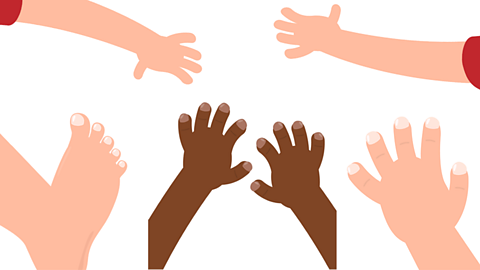
Did you know?
If there’s more than one of something, you normally add s to the noun to make it plural:
- Sorry, something went wrongCheck your connection, refresh the page and try again. – one leg
- Sorry, something went wrongCheck your connection, refresh the page and try again. – two legs
If the word ends in s, x or z, you don’t need to add s:
- Sorry, something went wrongCheck your connection, refresh the page and try again. – one arm becomes Sorry, something went wrongCheck your connection, refresh the page and try again. – two arms
- Sorry, something went wrongCheck your connection, refresh the page and try again. – one nose becomes Sorry, something went wrongCheck your connection, refresh the page and try again. – two noses
Watch out for the exception as the word for 'eye' in French looks and sounds completely different when there's more than one!
- Sorry, something went wrongCheck your connection, refresh the page and try again. – one eye
- Sorry, something went wrongCheck your connection, refresh the page and try again. – two eyes

Using the verb 'to have' in French
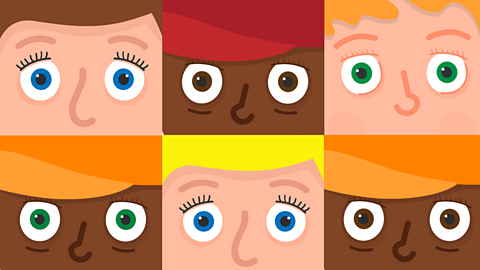
In French, Sorry, something went wrongCheck your connection, refresh the page and try again. is a useful verb to use when describing yourself. It means 'to have'.
If you’re talking about yourself, you use j'ai – I have.
- Sorry, something went wrongCheck your connection, refresh the page and try again. – I have a nose
- Sorry, something went wrongCheck your connection, refresh the page and try again. – I have two ears
If you’re talking about someone or something else, you use il a (he has) or elle a (she has).
- Sorry, something went wrongCheck your connection, refresh the page and try again. – He has a nose
- Sorry, something went wrongCheck your connection, refresh the page and try again. – She has two ears
You can learn more about how to use this verb in the 2nd level article Avoir - to have.

Describing a monster in French
Imagine you’re describing a monster. You could say they have three eyes and four arms. For this, you need some numbers.
| French | English |
|---|---|
| Sorry, something went wrongCheck your connection, refresh the page and try again. | one |
| Sorry, something went wrongCheck your connection, refresh the page and try again. | two |
| Sorry, something went wrongCheck your connection, refresh the page and try again. | three |
| Sorry, something went wrongCheck your connection, refresh the page and try again. | four |
| Sorry, something went wrongCheck your connection, refresh the page and try again. | five |
| Sorry, something went wrongCheck your connection, refresh the page and try again. | six |
| Sorry, something went wrongCheck your connection, refresh the page and try again. | seven |
| Sorry, something went wrongCheck your connection, refresh the page and try again. | eight |
| Sorry, something went wrongCheck your connection, refresh the page and try again. | nine |
| Sorry, something went wrongCheck your connection, refresh the page and try again. | ten |
Now you can say:
- Sorry, something went wrongCheck your connection, refresh the page and try again. – He has three eyes
- Sorry, something went wrongCheck your connection, refresh the page and try again. – He has four arms
- Sorry, something went wrongCheck your connection, refresh the page and try again. – He has four hands
- Sorry, something went wrongCheck your connection, refresh the page and try again. – He has six legs
- Sorry, something went wrongCheck your connection, refresh the page and try again. – He has six feet
You could describe a monster and your friend could draw it!
Here are some monsters for you to describe.
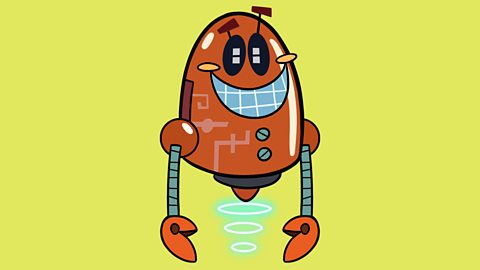
Image caption, Botmonster
Can you say in French how many arms this monster has?
Image caption, Botmonster
Well done! You could say 'Il a deux bras' - He has two arms.
Image caption, Gulp
Can you say how many eyes this monster has in French?
Image caption, Gulp
Brilliant! You could say 'Elle a cinq yeux' - She has five eyes.
Image caption, Dasher
Describe this monster in French.
Image caption, Dasher
There are lots of ways to describe this monster, for example 'Il a deux jambes' - He has two legs.
Image caption, Monsterose and Snaffler
Can you describe these monsters in French?
Image caption, Monsterose and Snaffler
Fantastic! There are lots of ways to describe these two monsters. For the pink monster, you could say 'Elle a un œil' - She has one eye. For the green monster, you could say 'Il a quatre jambes' - He has four legs.
1 of 8
Hair colour in French
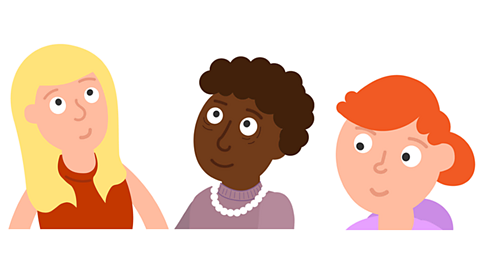
If you would rather describe yourself, you’ll also want to talk about the colour of your hair.
Here are some adjectives or describing words to help you describe hair.
| French | English |
|---|---|
| Sorry, something went wrongCheck your connection, refresh the page and try again. | blonde |
| Sorry, something went wrongCheck your connection, refresh the page and try again. | brown |
| Sorry, something went wrongCheck your connection, refresh the page and try again. | black |
| Sorry, something went wrongCheck your connection, refresh the page and try again. | red |
| Sorry, something went wrongCheck your connection, refresh the page and try again. | short |
| Sorry, something went wrongCheck your connection, refresh the page and try again. | long |

In French, hair (Sorry, something went wrongCheck your connection, refresh the page and try again.) is plural, so the adjective which describes it needs to be plural too. So you must add an s on the end of the adjective, which goes after the noun.
- Sorry, something went wrongCheck your connection, refresh the page and try again. – I have blonde hair
- Sorry, something went wrongCheck your connection, refresh the page and try again. – I have brown hair
- Sorry, something went wrongCheck your connection, refresh the page and try again. – I have black hair
- Sorry, something went wrongCheck your connection, refresh the page and try again. – I have long hair
- Sorry, something went wrongCheck your connection, refresh the page and try again. – I have short hair
Eye colour in French
To talk about the colour of your eyes, you can use these colours.
| French | English |
|---|---|
| Sorry, something went wrongCheck your connection, refresh the page and try again. | blue |
| Sorry, something went wrongCheck your connection, refresh the page and try again. | brown |
| Sorry, something went wrongCheck your connection, refresh the page and try again. | green |

Again, you need to add s to the adjectives as you have two eyes. Note the exception Sorry, something went wrongCheck your connection, refresh the page and try again. which never changes its spelling, even if describing a plural noun.
- Sorry, something went wrongCheck your connection, refresh the page and try again. – I have blue eyes
- Sorry, something went wrongCheck your connection, refresh the page and try again. – I have green eyes
- Sorry, something went wrongCheck your connection, refresh the page and try again. – I have brown eyes
To describe someone else’s hair or eyes, you can say:
- Sorry, something went wrongCheck your connection, refresh the page and try again. – He has blonde hair
- Sorry, something went wrongCheck your connection, refresh the page and try again. – She has brown hair
- Sorry, something went wrongCheck your connection, refresh the page and try again. – He has blue eyes
- Sorry, something went wrongCheck your connection, refresh the page and try again. – She has green eyes
Now you can describe yourself or a friend!

Body parts and instructions
You can practice body parts when you are warming up for PE or taking an active brain break in class. Here are some examples for you to try!
| French | English |
|---|---|
| Sorry, something went wrongCheck your connection, refresh the page and try again. | ∞’¥«≥Ð≥¶≥ۂĶ |
| Sorry, something went wrongCheck your connection, refresh the page and try again. | ∏È¥«±Ù±Ù‚Ķ |
| Sorry, something went wrongCheck your connection, refresh the page and try again. | Touch your head |
| Sorry, something went wrongCheck your connection, refresh the page and try again. | Roll your head |
| Sorry, something went wrongCheck your connection, refresh the page and try again. | Touch your shoulders |
| Sorry, something went wrongCheck your connection, refresh the page and try again. | Roll your shoulders |
| Sorry, something went wrongCheck your connection, refresh the page and try again. | Touch your feet |
| Sorry, something went wrongCheck your connection, refresh the page and try again. | Roll your hips |
Body parts with definite articles (Le, la, ±Ù‚Äô, les etc.)
| French | English |
|---|---|
| Sorry, something went wrongCheck your connection, refresh the page and try again. | the head |
| Sorry, something went wrongCheck your connection, refresh the page and try again. | the eyes |
| Sorry, something went wrongCheck your connection, refresh the page and try again. | the nose |
| Sorry, something went wrongCheck your connection, refresh the page and try again. | the mouth |
| Sorry, something went wrongCheck your connection, refresh the page and try again. | the arms |
| Sorry, something went wrongCheck your connection, refresh the page and try again. | the hips |
| Sorry, something went wrongCheck your connection, refresh the page and try again. | the legs |
| Sorry, something went wrongCheck your connection, refresh the page and try again. | the knees |
| Sorry, something went wrongCheck your connection, refresh the page and try again. | the feet |
Key French sounds
Below are some important French sounds that you have heard in this topic. Try practising them yourself out loud.
- un
The word Sorry, something went wrongCheck your connection, refresh the page and try again. is very common as it means 'a' or 'one'. The two letters make a nasal sound, which means that air comes down your nose, as well as through your mouth. The letters um also make the same sound.
Sorry, something went wrongCheck your connection, refresh the page and try again. – a foot
- in, ain
in and ain are also nasal sounds. These letters sound like the English an in ran. Put your mouth in the position to say an, then allow the air to come down your nose.
Sorry, something went wrongCheck your connection, refresh the page and try again. – five
Sorry, something went wrongCheck your connection, refresh the page and try again. – a hand
- Liaison
When s or x appear before a vowel, they make an English z sound.
Usually, when you say the number 'two' in French, you don't hear the x on the end of the word – Sorry, something went wrongCheck your connection, refresh the page and try again..
In the sentence Sorry, something went wrongCheck your connection, refresh the page and try again. (he has two ears), the x on the end of deux is not silent. In the middle of deux and oreilles, you hear a z so they sound like one word. This is called liaison and happens often in French.
More on Talking topics
Find out more by working through a topic
- count1 of 12
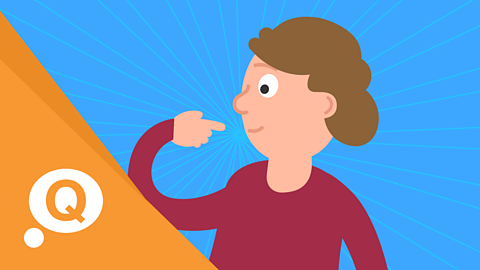
- count2 of 12
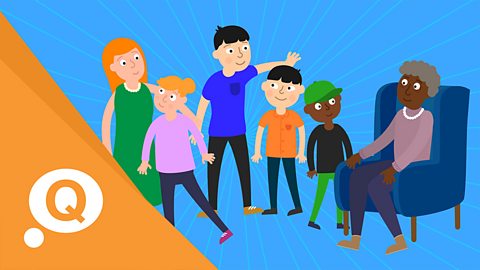
- count3 of 12

- count4 of 12
